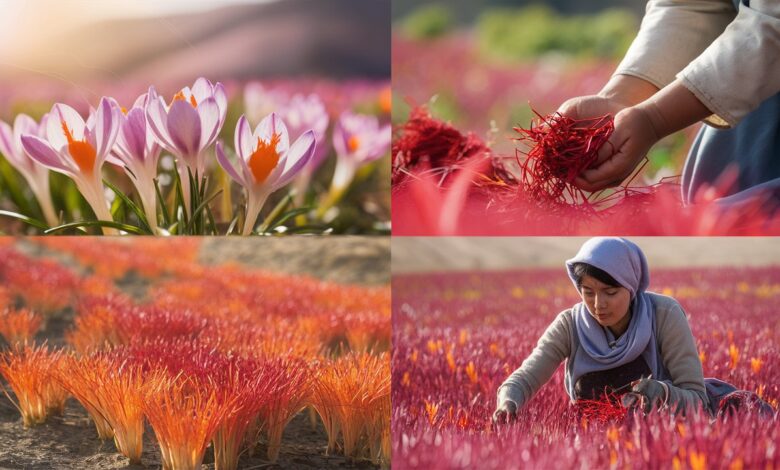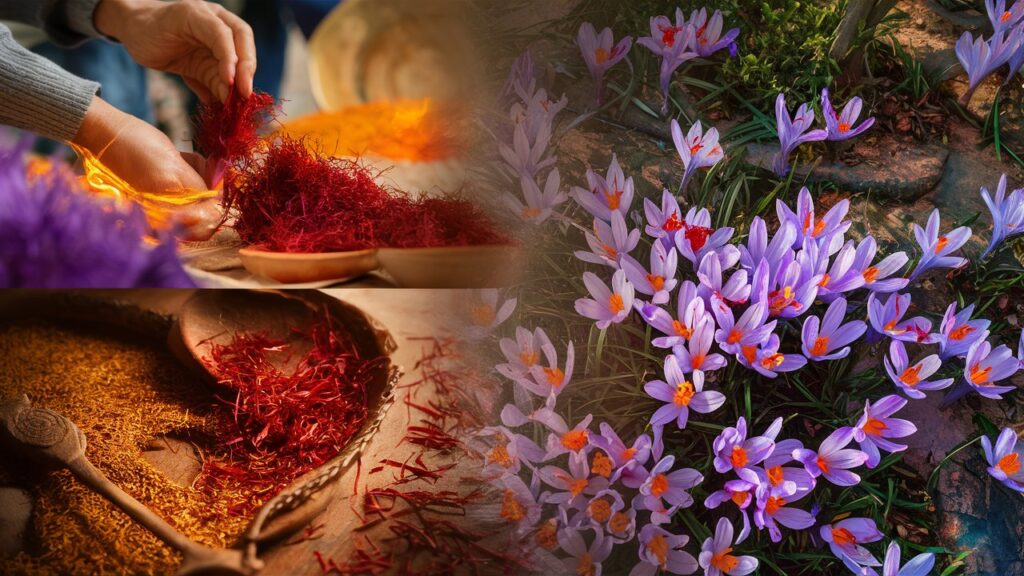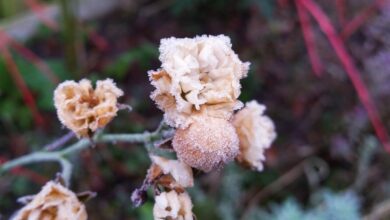The Golden Treasure: Exploring Saffron the World’s Most Precious Spice

Introduction: A Thread of Luxury Woven Through Time
Saffron, the vivid crimson threads derived from the delicate Crocus sativus flower, transcends the realm of mere spice. For millennia, it has captivated civilizations, commanding prices higher than gold itself and earning the evocative title “Red Gold.” Its allure lies not only in its potent ability to imbue dishes with a unique, honey-like floral aroma and a mesmerizing golden hue but also in its rich tapestry of history, labor-intensive cultivation, and reputed therapeutic properties. This ancient treasure, mentioned in Egyptian papyri, Greek myths, and Persian epics, has colored royal garments, flavored sacred foods, and served as a coveted medicine. Understanding saffron requires delving into its origins, the painstaking process that brings it to our tables, its complex chemistry, its multifaceted uses, and the art of discerning true quality. This journey reveals why a few fragile threads continue to hold such profound value and fascination in the modern world, connecting us to a heritage of sensory delight and cultural significance.
The Origins and Cultivation of Saffron Crocus
The story of saffron begins with the Saffron Crocus, Crocus sativus, a sterile triploid mutant believed to have originated in ancient Greece or Southwest Asia, possibly from the wild species Crocus cartwrightianus. Unlike most plants, it cannot reproduce sexually via seeds; its propagation relies entirely on human intervention through the division and replanting of its underground corms (bulb-like structures). This biological quirk means every saffron crocus plant in existence is essentially a clone, its lineage stretching back thousands of years. Cultivation demands specific conditions: well-drained, calcareous soil, abundant sunshine, and a distinct climate pattern with hot, dry summers and cool, relatively moist autumns. Major producing regions today include Iran (dominating over 90% of global production), India (particularly Kashmir), Spain, Greece, and Morocco. The corms are planted in summer, lie dormant, and then, as autumn arrives, send up their precious purple flowers, each bearing the three coveted crimson stigmas. The plant’s complete dependence on manual labor for propagation and harvesting is the fundamental reason behind its extraordinary cost and scarcity.
The Meticulous Harvesting and Processing of Saffron Threads
The term Saffron Harvesting refers to a brief, intense, and incredibly delicate annual event that defines the spice’s value. The Crocus sativus flowers bloom unpredictably over a window of just 1-3 weeks in autumn, often at dawn. They must be harvested by hand on the very same day they open, before they wilt, typically within a few morning hours. This labor requires speed, precision, and a vast workforce. Imagine the scene: fields dotted with workers bending down to gently pluck each ephemeral bloom. Following harvest comes the even more delicate stage: Stigma Separation. Each flower yields only three vivid red stigmas – the precious “threads.” These must be painstakingly plucked from the flower by hand, a task demanding exceptional dexterity and patience. It takes approximately 150,000 flowers to produce just one kilogram of dry saffron threads, a staggering statistic that underscores the immense human effort involved. After separation, the fragile stigmas undergo careful Drying (traditionally over low heat or on fine meshes in warm, dry air), a critical process that concentrates their flavor, aroma, and color while reducing moisture to prevent spoilage. This stage significantly reduces their weight (fresh stigmas are mostly water) and locks in their precious compounds. Finally, the dried threads are graded and packaged, ready to be shipped as the world’s most valuable spice.
The Chemistry Behind Saffron’s Color, Flavor, and Aroma
Saffron’s magic isn’t just folklore; it’s rooted in a complex and fascinating Saffron Chemistry. Three primary groups of compounds are responsible for its sensory impact:
- Crocin: These water-soluble carotenoids are the powerhouse behind saffron’s legendary Color Quality. When infused in water or other liquids, crocins release an intense, vibrant golden-yellow hue. The concentration of crocin directly correlates with saffron’s coloring strength, a key quality metric.
- Picrocrocin: This bitter glycoside is the primary contributor to saffron’s distinctive Flavor Profile. It provides the characteristic earthy, hay-like, slightly bitter base note that underpins the spice’s overall taste.
- Safranal: This volatile compound, primarily formed during the drying process from the breakdown of picrocrocin, is the essence of saffron’s enchanting Saffron Aroma. It delivers the highly prized, complex floral, honey-like, and slightly metallic fragrance that makes saffron so unique and irreplaceable in perfumery and cuisine. The precise balance and concentration of these three compound groups, influenced by origin, climate, harvesting time, and drying technique, define the ultimate sensory character and quality grade of any batch of saffron.
Culinary Uses: Saffron as a Flavoring and Coloring Agent

In the realm of Culinary Uses, saffron reigns supreme as both a Flavoring Agent and a Coloring Agent, transforming ordinary dishes into extraordinary culinary experiences. Its application is diverse, spanning global cuisines. A few threads, gently toasted and crushed, then steeped in warm liquid (water, broth, milk, or alcohol), unlock its full potential, infusing the base with its signature golden hue and complex aroma. Iconic dishes showcase its versatility: Spanish Paella relies on saffron for its vibrant color and distinctive flavor; Italian Risotto alla Milanese is defined by its rich golden tone; French Bouillabaisse gains depth from its inclusion; Persian Tahdig (crispy rice) and Chelow often feature its subtle perfume; and Indian Biryani and sweets like Kesar Pista Kulfi use it lavishly for both color and taste. Beyond savory dishes, saffron elevates baked goods (breads, cakes), desserts (custards, ice creams), and beverages (teas, liqueurs). Its power lies in its potency – a tiny amount suffices – and its ability to add a layer of sophisticated, aromatic complexity that is simply unmatched by any substitute.
Medicinal Properties and Health Benefits of Saffron
Beyond the kitchen, saffron boasts a long and esteemed history in traditional medicine systems like Ayurveda, Unani, and Persian medicine for its potential Medicinal Properties. Modern science is increasingly investigating these traditional claims, revealing a range of intriguing Health Benefits attributed largely to its potent antioxidant compounds, particularly crocin, crocetin, and safranal. Research suggests saffron may have Antioxidant Effects, helping to combat oxidative stress linked to chronic diseases. Studies point towards its potential as a natural Mood Enhancer, showing promise in alleviating symptoms of mild-to-moderate depression, possibly by modulating neurotransmitters like serotonin. Its traditional use for PMS Relief is supported by some clinical trials indicating it can reduce irritability, headaches, and pain associated with premenstrual syndrome. Other areas of research include potential benefits for learning and memory (Cognitive Function), eye health (specifically age-related macular degeneration due to carotenoids), appetite suppression, and anti-inflammatory effects. While results are promising, it’s crucial to note that much research is ongoing, often using concentrated extracts, and consuming culinary amounts is not a substitute for medical treatment. Consulting a healthcare professional is essential before using saffron therapeutically.
Assessing Saffron Quality and Understanding Grading
Given its high value, understanding Saffron Quality and Grading Systems is paramount for consumers seeking authenticity and value. Quality is primarily judged by three key characteristics derived from its chemistry: Coloring Strength (Crocin content), Flavor Strength (Picrocrocin content), and Aromatic Strength (Safranal content). Visually, high-quality saffron threads should be uniformly deep crimson red (the tops of the stigmas) with minimal yellow style (the lower portion) attached. The threads should be long, intact, dry, and brittle, not moist or clumped. ISO 3632 Grading is the international standard, classifying saffron based on laboratory measurements of crocin (color), picrocrocin (taste), and safranal (aroma) content, alongside moisture levels and floral waste. Categories within ISO 3632 range from Category I (highest quality) to Category III (lowest quality). Other regional classifications exist, like Spain’s ‘Coupe’, ‘La Mancha’, ‘Rio’, and ‘Sierra’ grades, or Iran’s ‘Sargol’ (pure red tops) and ‘Pushal’ (includes some yellow style). Kashmir grades its saffron as ‘Mongra’ or ‘Lacha’. Adulteration (adding fillers like dyed corn silk, safflower, or turmeric) is a persistent problem. Buying whole threads (not powder) from reputable suppliers, checking for certification (like ISO grading), and performing simple tests (like the cold water test where genuine saffron slowly releases yellow color, while dyes release red immediately) can help ensure authenticity.
Buying and Storing Saffron: Preserving the Red Gold
Buying Saffron wisely is essential to experience its true glory and ensure you get what you pay for. Prioritize reputable spice merchants, specialty stores, or directly from trusted producers/growers’ cooperatives. Always opt for whole threads over powder. Powdered saffron is significantly more susceptible to adulteration and loses its potency much faster. Examine the product: Look for threads that are vivid, uniformly deep red, with minimal yellow or orange parts, and avoid any that look dull, broken, or contain excessive plant debris. Packaging should be airtight and opaque (light degrades saffron). Check labels for origin, harvest date (if available), and ideally, an ISO grade. Price is a major indicator – genuine, high-grade saffron is expensive; prices significantly lower than the market average are a major red flag for adulteration or very low quality. Once acquired, Storing Saffron correctly is crucial to preserve its precious volatile oils and compounds. Keep it in an airtight container (glass is ideal) in a cool, dark, and dry place – a cupboard away from the stove or oven is perfect. Avoid heat, light, moisture, and strong odors. Refrigeration or freezing in an airtight container can extend shelf life further (up to 2-3 years), though some argue it can mute the aroma slightly compared to cool, dark cupboard storage (generally effective for 1-2 years). Properly stored, saffron retains its magical properties, ready to transform your dishes whenever called upon.
Conclusion: The Enduring Allure of Liquid Sunshine
Saffron is far more than just a spice; it is a sensory experience, a historical artifact, and a testament to nature’s intricate beauty and human dedication. From the fleeting autumn bloom of the delicate crocus to the back-breaking labor of hand-harvesting countless flowers and separating their fragile stigmas, the journey of saffron to our kitchens is one of remarkable effort and patience. Its vibrant color, complex aroma, and unique flavor profile, born from a sophisticated chemical interplay, have cemented its place as the undisputed king of spices for millennia. Whether elevating a simple rice dish to regal status, potentially offering therapeutic benefits rooted in ancient wisdom, or simply captivating us with its sheer rarity and beauty, saffron holds an enduring fascination. Understanding its origins, the meticulous craft behind it, its chemical essence, and how to discern and preserve its quality allows us to appreciate this “Red Gold” truly. When those precious threads steep in warm liquid, releasing their liquid sunshine, we partake in a tradition as old as civilization itself, savoring a luxury woven from sunlight, soil, and human hands.
Frequently Asked Questions (FAQs) About Saffron
- Why is saffron so expensive?
Saffron’s high cost is directly attributable to its incredibly labor-intensive production. Each Crocus sativus flower produces only three usable stigmas (threads). These flowers bloom for a very short period and must be harvested entirely by hand on the day they open. The subsequent process of carefully plucking the tiny stigmas from each flower is also done meticulously by hand. It takes an astonishing 150,000 to 200,000 flowers (requiring roughly 40 hours of labor) to produce just one kilogram of dried saffron. This immense human effort, combined with the plant’s specific climatic needs and limited growing regions, makes saffron the world’s most expensive spice by weight. - Is there a good substitute for saffron?
While nothing perfectly replicates saffron’s unique combination of vibrant golden color, complex floral-honey aroma, and distinct flavor, some alternatives can mimic aspects of it:- Color: Turmeric provides a similar yellow-orange hue but has a completely different (earthy, pungent) flavor and no saffron aroma. Safflower (often sold as “Mexican saffron” or “Bastard saffron”) offers a yellow-red color but lacks significant flavor or aroma.
- Flavor/Aroma: Annatto seeds (achiote) offer a slightly peppery, floral note and yellow color but are distinct. Marigold petals provide color but minimal flavor complexity.
Using these substitutes highlights that saffron’s true value lies in its irreplaceable complete sensory profile. If a recipe relies heavily on saffron’s unique character (like paella or risotto Milanese), substitutes will fall significantly short.
- How can I tell if my saffron is real or fake?
Detecting adulteration can be tricky, but here are key methods:- Buy Whole Threads: Avoid powder; it’s easier to adulterate.
- Appearance: Genuine threads are trumpet-shaped, vivid crimson red at the top, and may have a slight yellow/orange tip (style) attached. They should be brittle, not soft or moist. Dyed corn silk or other fibers often look unnaturally uniform or release dye when handled.
- Smell: Authentic saffron has a strong, distinct, floral-honey-metallic aroma. Fake saffron might smell musty, hay-like only, or have no scent.
- Taste: A genuine thread, when chewed, should taste initially slightly sweet, then bitter, leaving a lingering floral note. Fakes might be tasteless, overly bitter, or soapy.
- Water Test: Place a few threads in cold or lukewarm water. Genuine saffron will slowly (over 10-15 minutes) release a rich, clear yellow color. If the water turns red immediately, it’s likely dyed. Real saffron threads should remain mostly red.
- Source & Price: Buy from reputable sellers. Extremely low prices are a major warning sign. Look for origin information and ISO grading if possible.
- How much saffron should I use in a recipe?
Saffron is incredibly potent; a little goes a very long way. Most recipes for 4-6 servings typically call for a pinch (roughly 15-20 medium threads) or about 1/4 to 1/2 teaspoon of lightly crushed threads. Overuse can lead to an overpowering medicinal or bitter taste. It’s always better to start with less and add more if needed. Remember to “bloom” it: lightly crush the threads (to release oils), then steep them in a small amount of warm liquid (water, broth, milk, wine) for 10-20 minutes before adding this infusion (including the threads) to your dish. - How should I store saffron to keep it fresh?
To preserve saffron’s volatile aromatic compounds and prevent degradation of its color and flavor, store it properly:- Container: Keep it in an airtight container. Glass jars with tight-fitting lids are excellent.
- Location: Store the container in a cool, dark, and dry place. A cupboard or pantry away from heat sources (stove, oven), direct sunlight, and moisture is ideal.
- Avoid: Heat, light, humidity, and strong odors (saffron can absorb them).
- Long-Term Storage: For extended storage (beyond 6-12 months), you can place the airtight container in the refrigerator or freezer. This can help maintain potency for 2-3 years. Bring it to room temperature before opening to minimize condensation. Properly stored saffron retains its best quality for 1-2 years at room temperature in ideal conditions, gradually losing potency after that.



